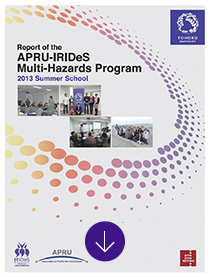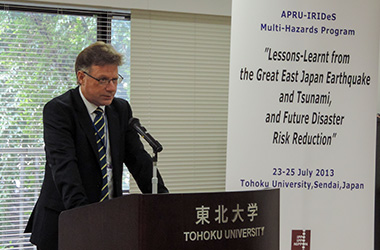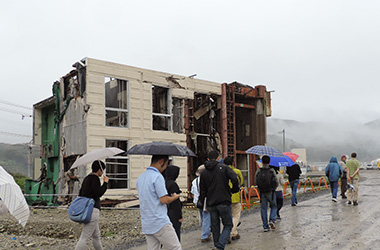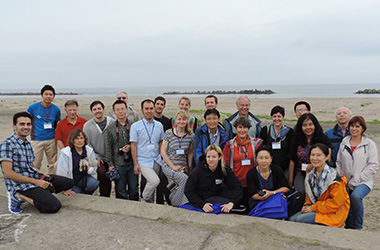“Lessons learnt from the Great Eastern Japan Earthquake and Tsunami and Future Disaster Risk Reduction”
he inaugural Multi-hazards Summer School was hosted and organized by IRIDeS, Tohoku University on 23-25 July 2013. It was attended by 31 participants from 9 countries (Australia, Chile, China, Japan, Malaysia, Philippines, Russia, Singapore, and USA). It consisted of 17 students, 13 faculty members and 1 APRU secretariat staff. The participants also visited Onagawa town, Ishinomaki city, Araham town, Yuriage town and the Thousand Year Hope Hill to observe the damage by the 2011 Great East Japan Earthquake and Tsunami and the reconstruction process.
The 2013 Multi-hazards Summer School objectives:
- Increase knowledge of the Hyogo Framework for Action (168 countries adopted at the UN World Conference on Disaster Reduction in 2005) and DRR initiatives in Japan;
- Share lessons and experiences on effective disaster preparedness from the Great East Japan Earthquake and Tsunami;
- Discuss the roles of universities/research institutes in DRR and their challenges; and
- Identify collaborative synergies among APRU universities in DRR and develop strategies to harness these.
“It is clear that with forecasts of increased intensity and frequency of disastrous events due to climate change, an interdisciplinary approach to natural hazards is essential. It will be critical that we share knowledge across countries, universities and research disciplines. The APRU network provides an excellent platform for working together and the summer school is a step in encouraging and fostering interdisciplinary research and learning.” (Ph.D Candidate, Department of Resource Management and Geography, University of Melbourne)
Report
-

- Report Summer School 2013
– 4.6MB – - Download
The agenda of the 2013 Summer School:
23 July 2013
| 09:00-09:25 | Opening ceremony |
|---|---|
| 09:25-09:40 | Introduction of participants |
| 09:40-10:40 | Activities and Roles of IRIDeS (Prof. Fumihiko Imamura, IRIDeS, Tohoku University) |
| 10:40-11:00 | Coffee break |
| 11:00-12:00 | Lessons-Learnt from the Great East Japan Earthquake and Tsunami(Prof. Shunsuke Managi, Graduate School of Environmental Studies, Tohoku University) |
| 12:00-13:00 | Lunch |
| 13:00-14:00 | History of Japanese Disaster Risk Reduction Efforts against Floods(Professor Emeritus, Nobuo Shuto, Tohoku University) |
| 14:00-15:00 | Disaster Risk Reduction and Safety from Natural Disasters on Campus(Prof. Masato Motosaka, IRIDeS, Tohoku University) |
| 15:00-15:20 | Coffee break |
| 15:20-16:00 | Disaster Reconstruction in Sendai City and Towards UN World Conference on Disaster Risk Reduction (Mr. Hiroshi Ishikawa, City of Sendai) |
| 16:00-17:00 | Hyogo Framework for Action and its Review (Prof. Osamu Murao, IRIDeS, Tohoku University) |
| 18:00- | Dinner reception at the Kokusai Hotel |
24 July 2013
| 09:00-10:00 | Lessons -Learnt from the Great East Japan Earthquake and Tsunami (Mr. Manabu Suzuki, City of Tagajo) |
|---|---|
| 10:00-11:00 | Disaster Risk Reduction in the Pacific Rim 1 (Distinguished Prof. John Rundle, Department of Geology, University of California, Davis) |
| 11:00-11:20 | Coffee break |
| 11:20-12:20 | Disaster Risk reduction in the Pacific Rim 2 (Prof. Hugo Romero, Department of Geography, University of Chile) |
| 12:20-13:30 | Lunch |
| 13:30-15:00 | Group work (Roles of universities in DRR) |
| 15:00-15:20 | Coffee break |
| 15:20-16:50 | Group presentation and discussions |
25 July 2013
Field trip to Onagawa town, Ishinomaki city, Araham town, Yuriage town and the Thousand Year Hope Hill







